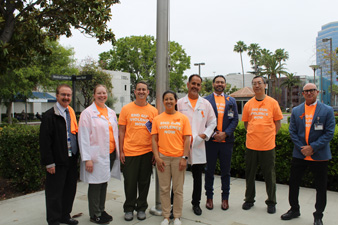UCI Medical Center marks National Gun Violence Awareness Day
Annual event honors and remembers lives lost to gun violence

Orange, Calif. — On June 7, UCI Medical Center joined National Gun Violence Awareness Day and Wear Orange Weekend, a nationwide movement to raise awareness about the impact of guns.
Attendees gathered at the medical center, the region’s leading trauma center and provider of critical care services, clad in orange attire. The vibrant color is worn by hunters for safety. It has now also become a symbol worn to honor the lives lost to gun violence.
Dr. Michael Lekawa, the adult and pediatric trauma medical director at UCI Health, opened the event with a call to action for change, noting that in 2019 gunshot wounds became the most common cause of death among children and adolescents over the age of 1.
“As a society we have found a way to make our cars and roads safety and to decrease both adult and pediatric mortality from care crashes,” he told the crowd.
“The same approach can certainly be applied to guns. It just takes enough of us to care.”
UCI Health, as Orange County's sole Level I adult trauma center, has played an integral role in caring for those affected by gun violence. In 2023 alone, the health system treated more than 120 patients with gunshot injuries, many of whom did not survive, Lekawa said.
UCI Health trauma surgeon Dr. Sigrid Burruss shared several sobering facts about gun violence in the United States:
- Every day, more than 120 Americans are killed with guns, a number that disproportionately affects Black and brown communities.
- Active shooter events have increased from 27 events in 2010 to 61 events in 2021.
- Eight out of ten murders and suicides in the U.S. involved a firearm. The number does not take into account the lives from trafficked guns associated with illegal drug sales and drug-related deaths.
- Suicides account for 54% firearm-related deaths, while 43% of murders are related to guns.
“Imagine, if instead of a simple reach for a firearm while severely depressed, this person did not have easy access and was able to receive mental health support?” Burruss asked.
“We can all help address and reduce gun violence. Our goal as trauma surgeons is to have no firearm injuries. That requires prevention starting here and now.”
UCI Health trauma surgeon Dr. Theresa Chin spoke about the increase of gun incidents in Orange County, noting that in 2023 alone, there were 161 firearm-related deaths, up from 157 in 2022. Of those, 74% were suicides, up from 68% the previous year.
“This is a public health problem that requires us to work together fix it. As a trauma surgeon, I dream of a day when firearm injuries are never seen,” Chin said.
Chin urged the attendees to consider attending a Stop the Bleed course, which was created by the American College of Surgeons Committee on Trauma. The courses teach anyone who to stop severe bleeding from a trauma. Limiting blood loss at the scene helps buy time for a victim to get to a hospital and ultimately survive, Chin noted.
Emergency physician Dr. Ronald J. Rivera spoke about the particular impact of gun violence on communities of color.
Although 33% of the county’s population identifies as Hispanic, they represent 66% of firearm homicide victims. Similarly, Black people are 1.5% of the county population, yet represent six times the number of gun violence victims.
“These statistics are harrowing, in that they show how gun violence, not only harms individuals or is a problem separate from our lives,” Rivera said. “But they show it as a plague that harms entire families and can destroy entire communities. It needs our attention.”
About UCI Health
UCI Health is the clinical enterprise of the University of California, Irvine, and the only academic health system in Orange County. Patients can access UCI Health at primary and specialty care offices across Orange County and at its main campus, UCI Medical Center in Orange, Calif. The 459-bed, acute care hospital, listed among America’s Best Hospitals by U.S. News & World Report for 23 consecutive years, provides tertiary and quaternary care, ambulatory and specialty medical clinics, behavioral health and rehabilitation services. UCI Medical Center is home to Orange County’s only National Cancer Institute-designated comprehensive cancer center, high-risk perinatal/neonatal program and American College of Surgeons-verified Level I adult and Level II pediatric trauma center, gold level 1 geriatric emergency department and regional burn center. UCI Health serves a region of nearly 4 million people in Orange County, western Riverside County and southeast Los Angeles County. Follow us on Facebook, Instagram, LinkedIn and Twitter.
About UCI Health — Irvine
UCI Health — Irvine, a new medical complex under construction at the north end of the UC Irvine campus, will bring unparalleled expertise and the finest evidence-based care that only an academic health system can offer to the communities of coastal and south Orange County. As part of UCI Health — which includes the flagship UCI Medical Center in Orange, Orange County’s only National Cancer Institute-designated comprehensive cancer center and multiple outpatient care locations — the new 1.2 million-square-foot campus will offer key clinical programs in oncology, digestive health, neurology, neurosurgery, orthopedics and spine surgery. The nation’s first all-electric, carbon-neutral medical center, UCI Health — Irvine is home to The Joe C. Wen & Family UCI Health Center for Advanced Care, a five-story, 168,000-square-foot medical facility offering the full range of multidisciplinary specialty care for children and adults under a single roof, urgent care services, the Center for Children’s Health and the UCI Health Center for Autism & Neurodevelopmental Disorders. Opening this summer: The Chao Family Comprehensive Cancer Center and Ambulatory Care, a 225,000-square-foot facility. Coming in 2025: A seven-story, 350,000-square-foot, acute care hospital.




